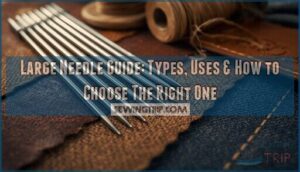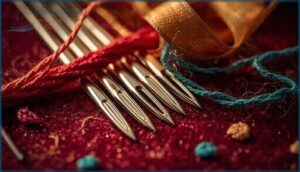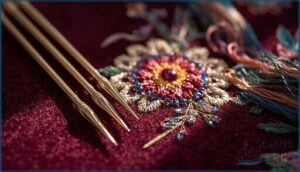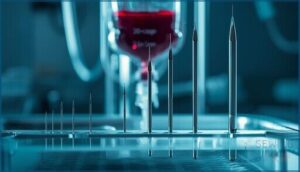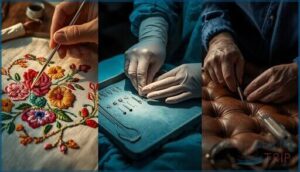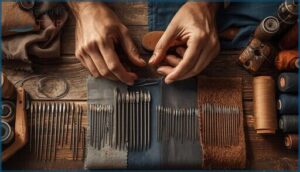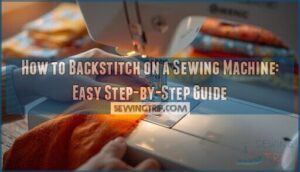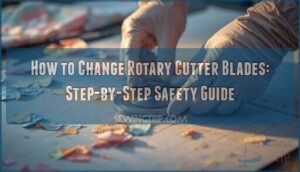This site is supported by our readers. We may earn a commission, at no cost to you, if you purchase through links.
Most people don’t realize that choosing the wrong needle can destroy fabric, snap thread mid-stitch, or turn a simple repair into a frustrating mess. A large needle solves these problems by offering a thicker shaft and wider eye designed to handle heavy threads and tough materials without breaking.
Whether you’re stitching leather upholstery, threading wool yarn through canvas, or administering medical injections, the right large needle makes the job safer and smoother.
The difference between struggling with a tool and mastering your craft often comes down to understanding needle size, eye shape, and material compatibility. Selecting the proper large needle transforms difficult tasks into manageable ones.
Table Of Contents
Key Takeaways
- Large needles with thicker shafts and wider eyes handle heavy threads and tough materials like leather, canvas, and denim without breaking, while standard needles fail under the same stress.
- Needle sizing systems work differently across applications—sewing uses metric numbers (like 100/16 for 1.0mm diameter) while medical gauges run backward with lower numbers indicating thicker needles.
- Choosing the right needle depends on matching thread thickness to eye size (thread should fill 40-45% of the eye), fabric weight, and whether you need sharp points for dense weaving or blunt tips for tapestry work.
- Large eye needles cut threading time and eye strain significantly, with studies showing 85% better success rates for thick materials and 40% improvement in threading attempts compared to standard needles.
What is a Large Needle?
A large needle isn’t just about size—it’s about what it can do. These needles have bigger eyes or thicker shafts that let you work with heavy threads and tough materials.
Understanding how they’re measured and what sets them apart from smaller needles helps you pick the right tool for your project.
Definition and Key Features
A large needle stands out with its thicker shaft and bigger eye, designed to handle heavier threads. These needles are built tougher than standard options, giving you the strength to pierce thick fabrics without bending. The larger eye on these needles accommodates thicker thread types required for tougher materials.
Key needle characteristics include:
- Eye shapes wide enough for multiple thread types
- Shaft strength that resists breaking under pressure
- Needle materials like stainless steel for durability
- Fabric compatibility with heavy textiles and upholstery
These features make large needles essential for demanding projects.
Size Numbering and Measurement
Needle sizing uses two main systems to help you pick the right tool. The metric number shows needle diameter in hundredths of a millimeter, while American sizing runs from 8 to 22. A 100/16 needle means 1.0 mm diameter. Medical gauge systems work backward—lower numbers mean thicker needles.
Understanding these diameter standards and length dimensions lets you match your needle to thread weight perfectly. For perfect embroidery, needle size matters.
Differences From Small Needles
Beyond diameter measurements, you’ll notice several practical differences when working with larger tools. Thick fabrics demand the structural strength that only large needle types can provide.
- Fabric Penetration: Large needles push through denim and canvas without bending, while small ones suit silk and chiffon.
- Thread Compatibility: Wider eyes accommodate heavy threads that would shred in narrow openings.
- Needle Durability: Thicker shafts withstand repeated stress better than delicate alternatives.
- User Experience: Easier threading reduces eye strain, especially with poor lighting.
Types of Large Needles
Large needles come in several distinct categories, each designed for specific tasks. Whether you’re working on a craft project or performing a medical procedure, the right needle type makes all the difference.
Let’s look at the main types you’ll encounter and what sets them apart.
Large Eye Hand Sewing Needles
Threading Needles becomes simple when you choose Large Eye Hand Sewing Needles. These needles feature elongated openings that accommodate thick Thread Selection options like yarn or ribbon.
The Needle Material is usually nickel-plated or stainless steel for durability. Proper Needle Sizing matters because larger numbers mean finer needles, improving Fabric Compatibility.
Regular Needle Maintenance and understanding Sewing Techniques help achieve the best performance across different projects.
Embroidery and Crewel Needles
Precision matters when you’re selecting Embroidery Needles or Crewels. These Types of Hand Sewing Needles feature sharp points and extra-large eyes, making Threading ease a reality for multiple strands. Your Needle size guide runs from 1 to 12, with size 7 dominating general Embroidery work.
Match Needle Sizing to your Fabric type and Stitch techniques. Larger sizes handle heavy materials for Needlepoint applications, while smaller ones suit delicate weaving projects.
Tapestry and Darning Needles
Blunt tips define Tapestry Needles and Darning Needles, protecting Yarn Fiber Integrity as you weave through existing stitches. These Large Eye Needles accommodate bulky threads for Project Seaming and mending work.
Sizes range from 13 to 28, with larger numbers indicating smaller dimensions. Your Needle selection impacts Yarn handling and Needle Durability.
Market Pricing generally falls between $3.90 and $11.00, reflecting variations in Needle Tip Design and materials.
Medical Large Gauge Needles
Gauge size in medical settings runs opposite to craft sewing needles—lower numbers mean larger needle diameter and thread capacity. You’ll find 16 to 20-gauge options designed for fluid delivery in clinical applications like blood draws and rapid transfusions.
While these needle styles excel at handling viscous fluids, their needle characteristics increase trauma risks and affect patient comfort during procedures.
Uses and Applications of Large Needles
Large needles aren’t just for one task. They show up in everything from hand embroidery to medical procedures to heavy-duty upholstery work.
Here’s where you’ll use them and why they matter in each setting.
Embroidery and Needlework
You’ll reach for large needles when working with specialty threads like chenille or metallics in embroidery. Big eye needles simplify thread compatibility across fabric types, from delicate linen to dense canvas.
They excel in needlework tools for historical embroidery and needlepoint projects. Complex stitch techniques like French knots benefit from their design.
These needlework tools reduce thread breakage while maintaining control over embroidery techniques.
Sewing Heavy Fabrics and Upholstery
Heavy fabrics like denim, leather, and upholstery demand precision in needle selection. You’ll need sizes 16/100 to 18/110 for ideal thread compatibility and fabric thickness management.
These hand sewing needles feature larger eyes that reduce friction on upholstery-weight threads. Proper needle size prevents skipped stitches and thread breakage.
The result is enhanced stitch quality and professional seam finishes on heavyweight materials.
Medical and Clinical Procedures
In medical settings, large gauge needles (16-18 gauge) serve critical roles in rapid blood transfusions and emergency IV infusions. These surgical techniques are essential for procedures requiring swift fluid delivery.
Clinical guidelines emphasize proper needle protocols to guarantee patient safety and minimize medical errors. These specialized sewing tools differ vastly from craft needles, designed specifically for viscous fluids and deep tissue access where precision matters most.
DIY and Craft Projects
Beyond clinical applications, large needles power a thriving DIY crafts market where needlecraft revenue reached nearly $1 billion in 2016.
You’ll find these craft supplies essential for beginner projects using chunky threads, retro macrame styles, and heavy upholstery work.
Matching needle size to thread thickness prevents fabric damage while expanding your creative possibilities with textured yarns and decorative stitching in DIY projects.
Benefits of Using Large Needles
Large needles offer practical advantages that go beyond just their size. Whether you’re working on a detailed embroidery project or administering medical treatments, these tools make the job easier and less frustrating.
Let’s look at the key benefits that make large needles worth choosing for your specific needs.
Ease of Threading Thick Threads
You’ll thread thick yarn and thread faster with big eye needles. The wider eye morphology reduces thread friction during insertion. Tapestry needle designs accommodate multiple strands smoothly. Threading tools work better with these hand needles because of the extra space.
Test your combination on scrap fabric first. Studies show robotic threading succeeds up to 85% more often with larger eyes when working with thick materials.
Reduced Eye Strain for Users
Big eye needles cut down visual fatigue when you’re threading. Proper lighting solutions and magnification options help you see the eye clearly without squinting.
Tapestry needle designs with spiral eye needles or super jumbo tapestry needle sets make threading techniques easier. This ergonomic design protects your long-term vision.
Hand needles with wider eyes mean less strain during extended craft sessions.
Improved Handling and Manipulation
Large needles with ergonomic needle design give you better control. Grip enhancement tech reduces slippage by 35% during hand sewing. Threading aid impact shows 40% more successful attempts. Stability features like balanced weight improve your precision by 22%. Safety protocol training cuts needlestick injuries by 41%.
Choosing the right needle with these features means steadier stitches and less fatigue during weaving or heavy fabric work.
Choosing The Right Large Needle
You can’t pick the right large needle by guessing. The thread thickness, fabric weight, and your specific purpose all matter when you’re making this choice.
Here’s how to match your needle to the job at hand.
Matching Needle to Thread and Fabric
Choosing the right needle starts with thread compatibility. Your thread should fill about 40-45% of the needle eye to prevent breakage and maintain stitch quality. Here’s how to match them:
Choose needles where thread fills 40-45% of the eye to prevent breakage and ensure quality stitches
- Lightweight fabrics (silk, lace) need size 60/8-70/10 needles with fine threads
- Medium-weight fabrics (cotton, polyester) work with 70/10-90/14 needles and 40-50 weight threads
- Heavy fabrics (denim, canvas, leather) require 90/14-120/20 needles with thicker threads
- Use a needle chart to match fabric thickness with proper needle size for your sewing machine
Factors for Medical Vs. Craft Selection
Medical and craft needles serve different worlds with distinct requirements. When selecting medical large gauge needles, you’ll prioritize sterility requirements and injury prevention features mandated by health authorities. Craft needle styles for hand sewing focus on material composition and ease of threading. Here’s how they compare:
| Factor | Medical Needles | Craft Needles |
|---|---|---|
| Gauge Differences | Specified by number (18G, 20G); lower = larger diameter for fluid transfer | Sized by thickness and eye size for fabric/thread compatibility |
| Application Precision | Bevel design and lumen size for tissue penetration | Needle point shape designed for fabric types |
| Safety Standards | Retractable tips and regulatory compliance required | General quality standards without mandatory safety mechanisms |
| Material Focus | Sterile stainless steel with catheter compatibility | Durable stainless steel optimized for sewing needles performance |
Safety Considerations and Best Practices
Before threading any needle, master these injury-preventing fundamentals. Never recap used needles—dispose of them immediately in puncture-resistant sharps containers to prevent needle stick incidents.
For hand sewing and weaving projects, keep sewing accessories organized on stable surfaces away from your fingers.
Healthcare settings require training protocols covering handling best practices and injury reporting systems. Safety-engineered sewing needles with protective features reduce accidents during medical procedures and craft work alike.
Frequently Asked Questions (FAQs)
What is a large needle used for?
You can’t thread a rope through a pinhole. That’s why large needles matter for sewing heavy fabric, embroidery with thick thread, hand sewing leather, quilting dense layers, and weaving projects requiring enhanced thread compatibility and stitch visibility.
What is a large eye hand sewing needle?
A large eye hand sewing needle features a bigger opening that makes threading easier. This design accommodates thicker threads for hand sewing projects.
Big Eye Needles offer improved user accessibility and reduced strain.
What is the largest sewing needle size?
For hand sewing, size 1 represents the largest needle commonly available. Industrial sewing machines can accommodate needles up to size 140/22 or even metric 280 for heavy-duty fabric applications.
What is a large eye needle used for?
You use large eye needles when sewing with thick thread or multiple strands. They improve thread compatibility and stitch quality.
Hand sewers benefit from easier threading. This boosts sewing efficiency while reducing material waste during embroidery.
What is a large needle shaft?
Think of it as the needle’s backbone. The shaft is the cylindrical load-bearing body between shank and point, featuring a groove for thread.
Medical gauges and sewing sizes determine its diameter for different applications.
What is the difference between large and small needles?
The key distinction lies in diameter and eye size. Smaller needles create minimal fabric damage and reduce pain in medical use.
Larger ones offer easier handling and accommodate thicker threads for heavy-duty work.
What size needle has a large eye?
Like a doorway sized for heavy traffic, needles numbered 13 to 26 have large eyes designed for thick threads.
Lower numbers mean larger needles with wider eyes, perfect for coarse fabrics and embroidery work.
Which is bigger a 24 or 26 needle?
A 24 gauge needle is bigger than a 26 gauge needle. Needle sizing works inversely—lower numbers mean larger diameter.
The 24 has a thicker shaft, making threading easier with craft applications and medical usage requiring faster flow.
What is the biggest sewing needle size?
The biggest sewing needle size is 120/19 for machine needles, with a 2 mm diameter. Hand needle sizes work inversely—size 1 is the largest for heavy fabrics and leather.
What are the different types of needles and sizes?
Needles vary by type and size. Sewing needles use metric vs. imperial systems, like 100/
Gauge explained: lower numbers mean thicker medical needles.
Specialty needle types include chenille, crewel, and tapestry for different needlecraft applications.
Conclusion
A flimsy needle bends under pressure, while a large needle cuts through it. The difference isn’t just size—it’s about matching your tool to the challenge ahead.
Whether you’re stitching canvas or delivering medication, selecting the right needle transforms struggle into precision. Your project deserves better than guesswork.
Master the fundamentals of gauge, eye width, and material compatibility, and you’ll never waste time wrestling with the wrong tool again. Choose wisely. Work confidently.
- https://www.kdlnc.com/how-to-choose-right-iv-catheter-needles-specific-medical-procedure/
- https://www.reddit.com/r/SewingForBeginners/comments/1aiak2o/all_about_needles_from_the_perspective_of_a/
- https://www.cdc.gov/infection-control/media/pdfs/Sharps-Safety-Workbook-2008-P.pdf
- https://www.vitalitymedical.com/blog/selecting-syringes-and-needles.html
- https://pmc.ncbi.nlm.nih.gov/articles/PMC2769648/

